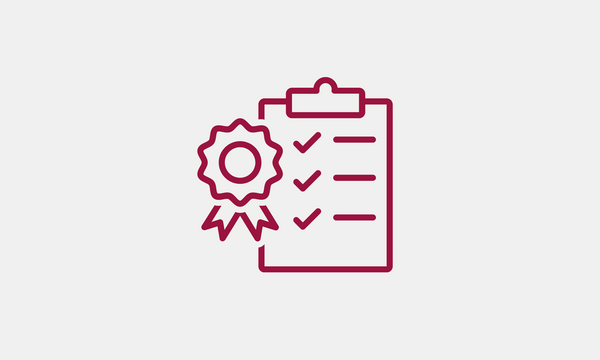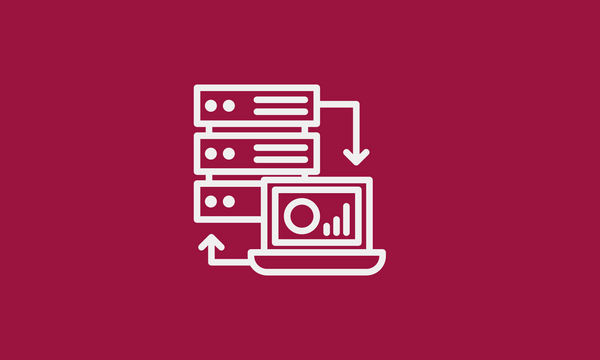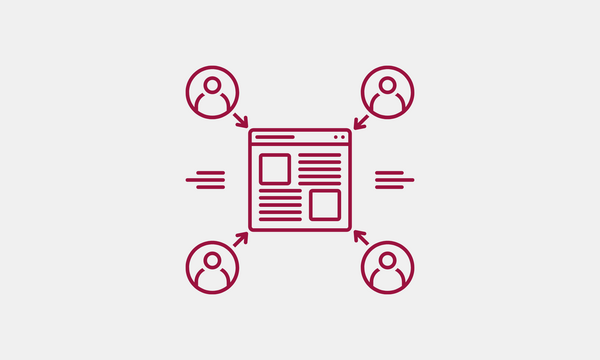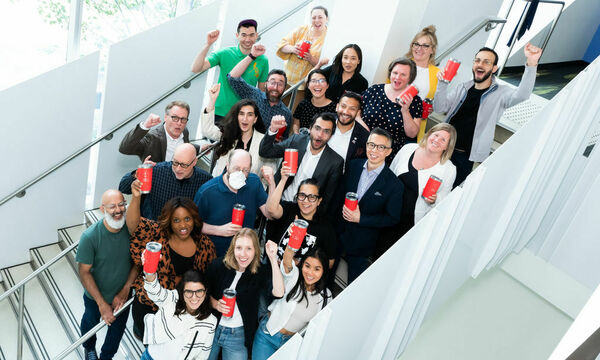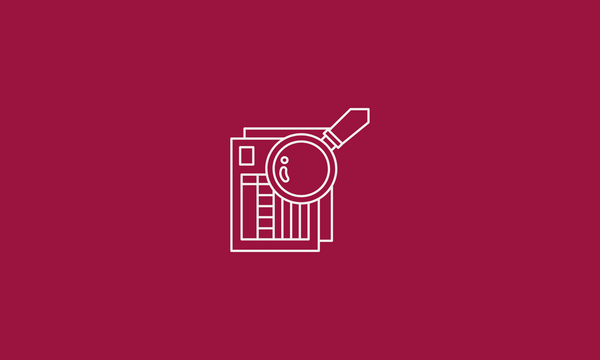Elevating the voice of the learner

Christine Lee
April 17, 2018
A journey of discovery
At the halfway mark of our Code for Canada fellowship, it feels like a good time to reflect on the past five months. Here’s what we’ve been up to.
In a nutshell, our engagement mandate with Ontario’s Ministry of Advanced Education and Skills Development (MAESD) is to build experiences that help adult learners find education programs that match their needs.
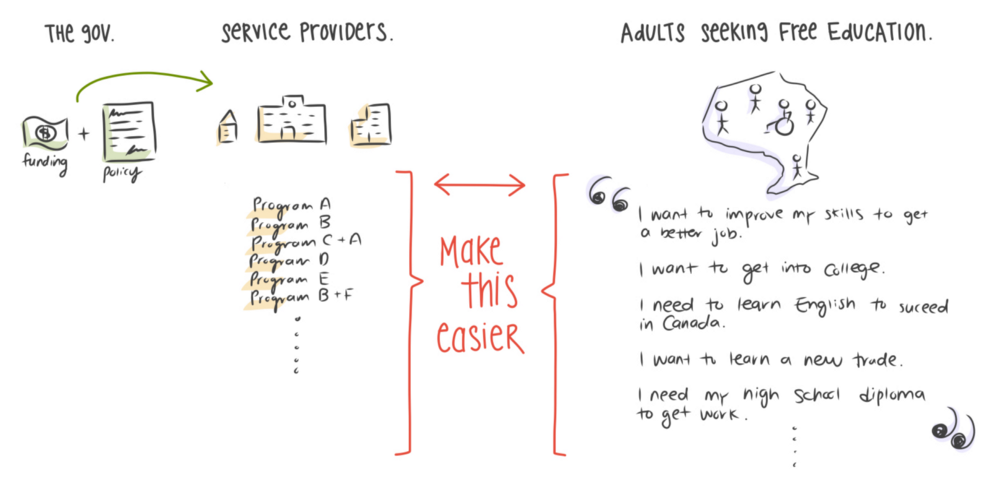
You can read more about adult education in Ontario in our first post.
Before putting code to machine we first needed to understand and validate where the problems reside. We began discovery by casting a wide net; this included interviews with internal staff across the four line ministries, collecting insights from existing research and discussion papers, looking into available data sources, and some extreme googling to find additional information about adult education programs, availability, eligibility, and definitions (more on this later…).
It was critical for us that we learn directly from learners: the people enrolled, or seeking to enrol in adult education programs. So, with help from our colleagues at MAESD, we arranged a series of regional focus groups and user interviews across Ontario and hit the road!

Speaking with 124 driven learners and 25 inspiring educators was an eye-opening and heart-warming experience. We often spent upwards of an hour and half listening to their stories of grit and resilience, while facilitating journey mapping and other research activities. The process gave us a lot of insight into learner’s motivations, emotions, behaviours and attitudes.
Based on what learned, we built some prototypes (pictured below), took them on the road and got them in front of learners. Through a combination of interviews, prototype testing and journey mapping we gained a better understanding of the primary pain points learners experience in their path towards further education and training.
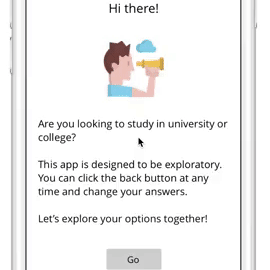

Building an experience map
After a few intense months of discovery and iterative prototyping, we took what we heard and synthesized it into an experience map (a blank version was also printed in large scale for workshop activities conducted directly with learners).

The purpose of this activity and artefact is to understand and empathize with the people we are designing for. The map highlights pain and gains in the adult education journey — as quoted directly by learners. The quotes above the white line are experiences that pulled the learner towards new behaviour (moving them towards education) while the stories below the line are experiences that pushed them away from new behaviour.
Carrying this document around with us to various meetings has served as an instrumental tool, not only find common ground during challenging conversations but also as a way to humanize the work we’re doing.
Revising the problem statement
Based on new knowledge, we also revised our original problem statement:
Initial problem statement: [Adult learners] struggle to find timely information that supports their decision making.
Revised: Today, adult learners experience decision fatigue and analysis paralysis due to overwhelming choice, conflicting directions, and/or disparate presentation of information. This inhibits them from being able to take their best next step towards further education.
Learning about learners
In analyzing our conversations with learners, we observed differing needs depending on where they were positioned on the spectrum of goal awareness and clarity towards their education/career targets.
Those with lower clarity around education and career goals are looking for solutions that help them determine what type of future best matches their personality and interests. Those which higher clarity around education and career goals are seeking solutions that helped them close skills gaps between where they are now and where they want to be.
While the focus of our engagement is around navigating choice, success in finding the right adult education program has dependencies beyond access and ease of information navigation. There are socioeconomic, financial, logistical, and emotional nuances that can create challenges for someone trying to find and succeed in adult education programs and we have to be very mindful of these factors.
After obtaining a fair representation of voices across Ontario, we clustered what we heard from educators, learners, and ministry staff into themes of what’s working well and what could be improved.
What’s working well?
- Learners become the advocates.
For the individuals who benefited from adult education programs, they are eager to share the good news with others who may also benefit from it. Word of mouth is a primary source of discovery.
“I put posters in my building for other people to find out about the class I’m taking. People need this.”
- Educators make all the difference.
Individuals expressed heartfelt praise for teachers who take time to care for the individual beyond the curriculum. Helping them with other aspects of their life such as connecting them to childcare subsidy programs and financial aid, being motivational coaches, and helping them plan steps beyond completion of the course.
“Teachers go beyond expectations. They are always available — even during break. They don’t treat you like a child — but as a human being.”
What can be improved?
- Lack of awareness.
We heard stories about a general lack of awareness about the availability of free adult education programs in Ontario and its benefits. There were also some misconceptions people had to overcome around one’s ability to continue learning in their older ages.
“I had no idea these types of programs existed… I wish I heard about this program five years ago!”
- Easier referrals between service providers.
Service providers often encounter individuals who they can’t service but still want to help out.
“There are a lot of [other] service providers who are not aware of us. It would make a difference if there was, say, across the three ministries there was a repository of the types of programs we all offer, then we could raise awareness and make better referrals.”
- A need for clear and complete information.
There are many siloed sources of information online and offline related to adult education programs making it challenging to compare and make a decision. Individuals also expressed mental exhaustion due to an abundance of advertising both from the public and private sectors.
“It would be nice to be informed accurately and have nice consolidated authoritative information about different programs instead of being marketed to.”
“I had to commute to multiple locations because I couldn’t get the information I needed over the phone or online.”
- A stronger connection between education and employment.
Learners expressed a desire for there to be a more streamlined experience between learning new skills and transitioning into employment.
“There should be more continuity between program support offerings and education programs such as connecting learners with job placements during the education process.”
- Stronger support needed during key transition moments.
Completion of a program offering is not the end of the individual’s journey. Individuals are looking to move into higher levels of education and/or employment which involves transitioning from one program into the next.
“There needs to be a better way to connect the program and the next step with my goal — my goal is not just to complete the program.”
“I’m feeling nervous about moving from this environment to a big adult classroom setting, it is very intimidating.”
From challenges to opportunities
The next step was to take these voices and identify key opportunity areas across the adult education journey. Four opportunity areas rose to the top that we believe when addressed, will take the adult education experience in Ontario to the next level:
- Increase adoption through greater awareness.
- Simplify the discovery cycle.
- Optimize the pipeline, to help learners move seamlessly move from discovery to learning in the classroom.
- Personalize the learning experience.
While the focus of our time here is to address No. 2, we’re mindful that this is just one piece of a complex system. Ideally we’d be able to touch all these areas but we have to prioritize a starting point. When defining this, we took into consideration which opportunity area would lend itself best to a digital solution and how each of these areas line up with the overarching policy mandates in place. Given our short time here it was important that we position our project in a way that would be a likely win/win for all parties — thereby allowing the team to deliver user value as quickly as possible.
The good news is that there are other in-flight and planned projects that are addressing some of the other areas. Our contribution in supporting these initiatives is to continuously share insights and to optimize project synergies where possible.
Next Steps
To simplify the discovery cycle we will be building a minimal viable product (MVP) that seeks to answer three user questions:
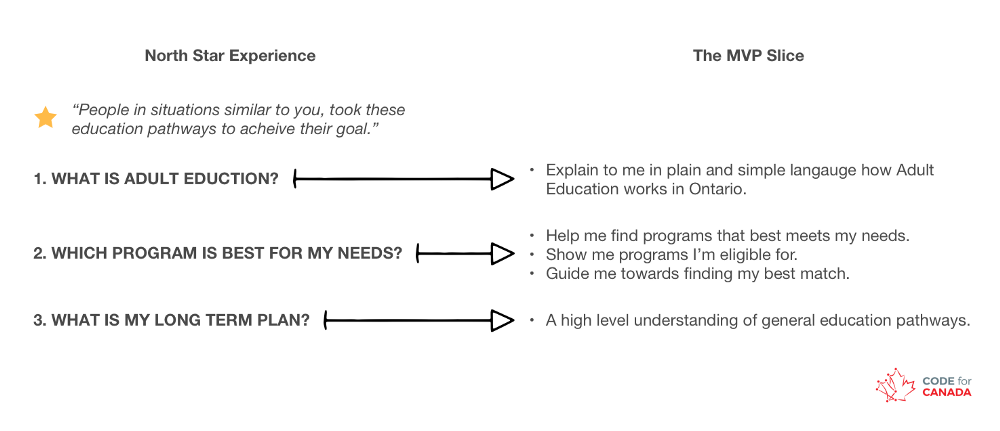
We are currently out on the road again testing it with users and so far so good!
If you are/know any adult learners looking for education and skills development who might be interested in helping us test our MVP, drop me a line at christine@codefor.ca, we’d love the feedback.
Thank you to all those who have supported us in getting this far, thank you for gifting us with your stories and welcoming us into your space. The feedback and insights continue to be invaluable and we’re working hard to make this work for you.
See you all soon for our next update!
The Code for Canada fellowship embeds technology professionals into government, where they work alongside public servants to build great digital services for residents. To learn more about becoming a fellow, or hosting a team of fellows in your department, visit codefor.ca/fellowship.
